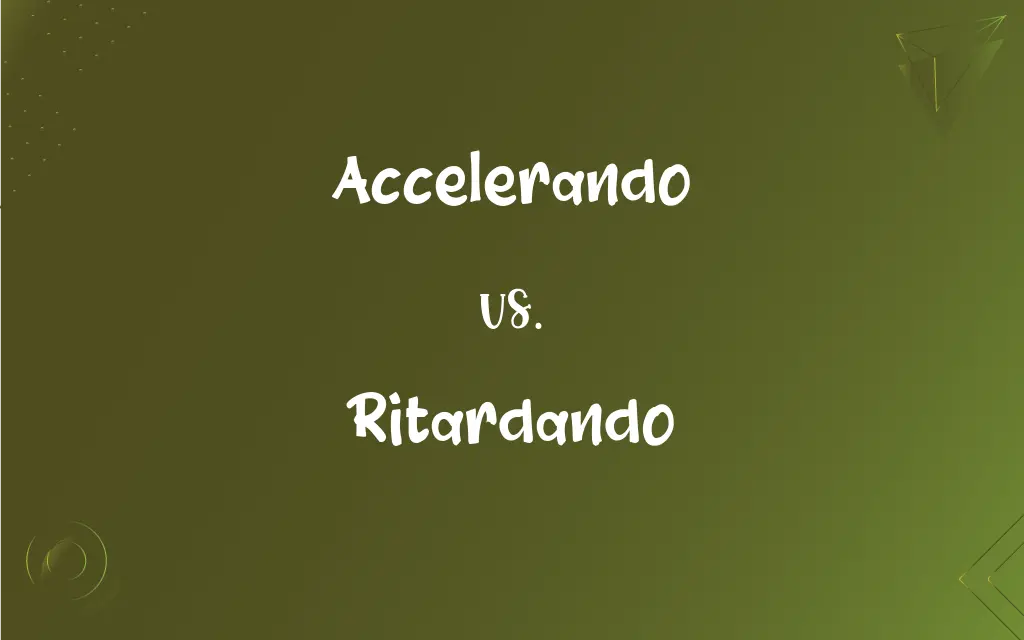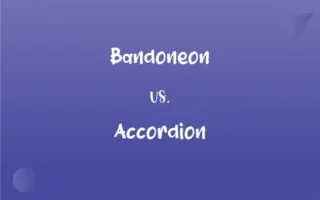Accelerando vs. Ritardando: What's the Difference?
By Harlon Moss & Janet White || Updated on May 22, 2024
Accelerando means gradually speeding up the tempo of music, whereas ritardando means gradually slowing down the tempo.

Key Differences
Accelerando refers to a gradual increase in the tempo of a musical piece, creating a sense of excitement and momentum. Ritardando, on the other hand, means gradually slowing down the tempo, bringing a piece to a more relaxed or deliberate pace.
In practice, accelerando injects energy and movement into music, making it feel more dynamic. Conversely, ritardando imparts a sense of calmness and deceleration, often providing a transition or conclusion.
Both terms are crucial in musical expression, guiding performers in interpreting the emotional and structural flow of a piece. Accelerando might be used in faster genres or intense passages, while ritardando is common in slower, more emotional sections.
Musicians must be attentive to these instructions, as accelerando requires synchronized speeding up, whereas ritardando demands coordinated slowing down, ensuring cohesive performance.
Comparison Chart
Definition
Gradually speeding up the tempo
Gradually slowing down the tempo
ADVERTISEMENT
Musical Impact
Creates excitement and momentum
Evokes calmness and relaxation
Common Usage
Leading into climactic sections
Signaling the end or reflective sections
Performance Technique
Synchronized increase in speed
Coordinated decrease in speed
Emotional Effect
Energizes the piece
Adds a contemplative feel
Accelerando and Ritardando Definitions
Accelerando
A notation indicating faster tempo.
The accelerando was clearly marked in the sheet music.
ADVERTISEMENT
Ritardando
Gradually slowing down the tempo.
The piece ended with a beautiful ritardando.
Accelerando
Increasing speed in a performance.
The pianist executed an accelerando during the cadenza.
Ritardando
Slowing the pace in a musical performance.
The ritardando added a dramatic effect to the song's conclusion.
Accelerando
Tempo change leading to a faster rhythm.
The dance became more lively with an accelerando.
Ritardando
A notation indicating slower tempo.
The ritardando was noted just before the final chord.
Accelerando
Gradually speeding up the tempo.
The orchestra played with an accelerando to reach the dramatic climax.
Ritardando
A musical directive to decrease speed.
The choir performed a ritardando as they approached the finale.
Accelerando
Gradually accelerating or quickening in time. Used chiefly as a direction.
Ritardando
Gradually slowing in tempo; retarding. Used chiefly as a direction.
Accelerando
An accelerando passage or movement.
Ritardando
(music) Gradually decelerating the tempo of a piece of music, especially at the end of the piece.
Accelerando
(music) A tempo mark directing that a passage is to be played at an increasing speed.
Ritardando
(music) Having a gradually decelerating tempo.
Accelerando
(music) A passage having this mark.
Ritardando
(music) An instance of gradually decelerating the tempo of a piece of music.
Accelerando
(by extension) Accelerating or exponential advancement or development (of a thing).
Ritardando
Retarding; - a direction for slower time; rallentado.
Accelerando
(music) With a gradual increase in speed.
Ritardando
Gradually decreasing in tempo
Accelerando
Gradually accelerating the movement.
Ritardando
Tempo change leading to a slower rhythm.
The conductor's hand signaled a ritardando for the ensemble.
Accelerando
A gradually increasing tempo of music;
My ear will not accept such violent accelerandos
Accelerando
Gradually increasing in tempo
Accelerando
With increasing speed;
Here you must play accelerando
Accelerando
A directive in music to quicken the pace.
The conductor signaled for an accelerando in the final movement.
FAQs
Can accelerando and ritardando appear in the same piece?
Yes, they can be used in different sections to create dynamic contrast.
How is ritardando used in a musical piece?
Ritardando is used to gradually slow down the tempo, often to signal an ending or transition.
What is the visual notation for ritardando?
Ritardando is often abbreviated as "rit." or "ritard." in sheet music.
What role does ritardando play in a musical performance?
It helps create a sense of closure or transition within the piece.
Are accelerando and ritardando difficult to perform?
They require careful timing and coordination among musicians.
What does accelerando mean in music?
Accelerando means gradually increasing the tempo of the music.
Do accelerando and ritardando affect the emotional tone of music?
Yes, accelerando adds excitement, while ritardando creates a more reflective mood.
Is accelerando always fast-paced?
It starts at the current tempo and speeds up progressively, not necessarily fast initially.
How do musicians follow an accelerando directive?
Musicians gradually increase their playing speed in unison.
Can a single piece contain multiple accelerandos and ritardandos?
Yes, multiple tempo changes can occur to suit the piece's structure and mood.
Does ritardando affect the overall duration of a piece?
It can slightly lengthen the piece by slowing down the tempo.
Do these terms only apply to classical music?
No, they can be used in various musical genres to indicate tempo changes.
Is it common for accelerando to lead to a ritardando?
It can happen, especially to create a dramatic contrast.
Can accelerando be sudden?
Typically, accelerando is gradual, but it can lead into a sudden faster tempo.
What is the difference in notation between accelerando and ritardando?
Accelerando may be abbreviated as "accel.", while ritardando as "rit." or "ritard."
How do musicians practice accelerando?
They use metronomes or conductor guidance to gradually increase speed.
How do accelerando and ritardando enhance musical expression?
They provide dynamic shifts in tempo, enhancing the emotional impact.
What is the purpose of an accelerando?
To increase excitement and momentum in the music.
What is a common sign for ritardando in music?
It is often marked with "rit." or a similar abbreviation.
Can both terms be used in a rehearsal for emphasis?
Yes, conductors frequently use them to direct tempo changes during practice.
About Author
Written by
Harlon MossHarlon is a seasoned quality moderator and accomplished content writer for Difference Wiki. An alumnus of the prestigious University of California, he earned his degree in Computer Science. Leveraging his academic background, Harlon brings a meticulous and informed perspective to his work, ensuring content accuracy and excellence.
Co-written by
Janet WhiteJanet White has been an esteemed writer and blogger for Difference Wiki. Holding a Master's degree in Science and Medical Journalism from the prestigious Boston University, she has consistently demonstrated her expertise and passion for her field. When she's not immersed in her work, Janet relishes her time exercising, delving into a good book, and cherishing moments with friends and family.































































